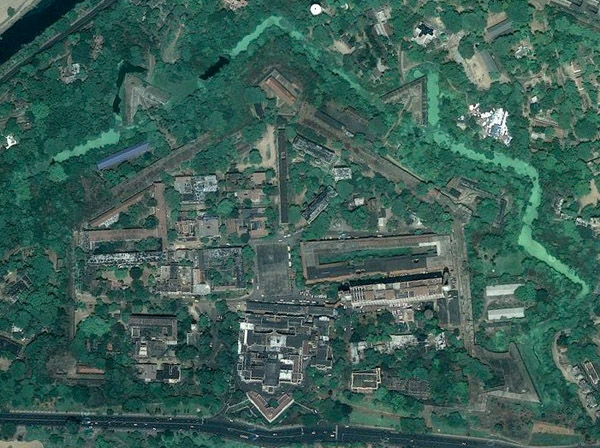
 |
 |
Fort St. George Chennai, India |
 |
 |
 |
 |
 |
||
 |
Once the Spanish Armada had crumbled in on itself, subsequently failing to conquer England in 1588, London merchants began casting their greedy little eyes towards the Indian Ocean. The British
East India Company was granted a charter on December 31 1600 by Britain's Queen Elizabeth I (1533-1603), in the interest of spreading British trade into the inky darkness of India and China. The Dutch and Portuguese
were already set up for business in that area, however, which led to costly sea battles. The Company realized it needed a proper foothold in India from which to sally forth on its brave mission of making money. In 1608 the British chose Suryapur (the current city of Surat) as that foothold, but it soon became evident that they would need a location closer to the Malaccan Straits, through which most of their spice-laden ships needed to sail. The Company bought a small strip of land at what would become the city of Madras (now Chennai) in 1639 from Venkatapathy, the Nayak of Vandavasi, and immediately set about building a warehouse and, in 1640, Fort St. George. The fort was completed on April 23 1640, St. George's Day in England: Hence its name! There were nothing but a few fishing villages in the immediate area in 1640, but the fort swiftly became a commercial hub, despite the presence of both Dutch and Portuguese settlements close by. By the 1720's, France was increasingly nosing into the area as well, and was predictably at odds with British interests. A perfectly ridiculous succession issue involving Austrian Maria Theresa (1717-1780), heir to the Habsburg throne ("OH no she's not!"), gave all of the powers in Europe an excellent excuse to return to their natural state, which was at each others' throats. The War of Austrian Succession (1740-1748) managed to involve almost every European nation (the Polish-Lithuanian Commonwealth sat this one out), and of course those nations' colonial holdings were part of the equation. France captured Fort St. George and Madras in 1746 and held them until the Treaty of Aix-Chapelle (October 18 1748) both ended the war and returned city and fort to Britain. Oddly, the Indians who were doing all the work that was making all the money for the East India Company were displeased with being treated like slaves. The Great Mutiny (known as the First War for Independence by the Indians) struck in 1857. Though the Company retained its hold over India, there was so much destruction and bloodshed that the British government, holding the Company responsible for allowing such nonsense to occur, nationalized the East India Company in 1858. The Company was dissolved in 1874. Fort St. George has served as Madras' administrative center for over 350 years. Within the fort are St. Mary's Church, completed in 1680 and the oldest Anglican church in India; The fort museum, built in 1795 as the office of the Madras Bank, today housing many artifacts of British rule; and the Secretariat, or official government buildings. In 1965 during violent protests over the naming of Hindi as India's official language, 50,000 Madras college students marched to Fort St. George to petition the Chief Minister, but were ignored and went away. Today Fort St. George is a popular tourist attraction, very well preserved by all accounts...but everyone also suggests doing one's sightseeing early in the morning in an air-conditioned taxi, or else one will succumb to the murderous heat and expire. |
 |
 |
||
|
|
|||||||
Info Source 1
Info Source 2
Info Source 3
Info Source 4 Info Source 5 Info Source 6 Info Source 7 Info Source 8 Info Source 9 Info Source 10 Info Source 11 Info Source 12 Info Source 13 Thanks to Google Maps for the image! ©2010 starforts.com |
 |